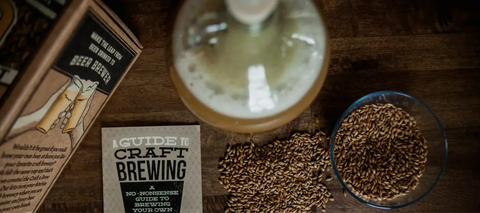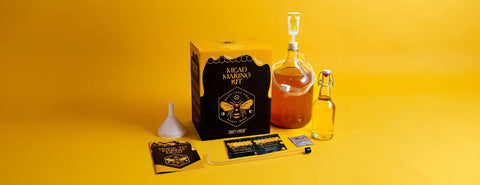TL;DR: Liquid yeast offers a wide range of strains and high cell counts for complex beers, while dry yeast is convenient and has a longer shelf life. Choose liquid yeast for unique flavors and precise control, or dry yeast for ease and reliability in standard brews.
When it comes to brewing beer, yeast plays a crucial role in fermentation, flavor, and overall quality. But with liquid yeast vs dry yeast, which is the better option for your homebrew? While both yeast types for beer brewing can produce excellent results, they have key differences that impact fermentation, storage, and ease of use.
At Craft a Brew, we use dry yeast for beer brewing in all of our beer kits because it’s reliable, shelf-stable, and beginner-friendly. However, liquid yeast for beer making is an excellent choice for advanced brewers looking for precise strain selection and unique flavor contributions. Whether you're brewing a crisp lager, a hop-forward IPA, or a rich stout, choosing yeast for beer is one of the most important steps in crafting a high-quality homebrew.
When deciding between liquid yeast vs dry yeast, it's important to consider how each affects the fermentation process, yeast health, and overall beer quality.
- Liquid yeast benefits include access to a wider range of beer yeast strains, giving brewers the ability to fine-tune fermentation and achieve distinct characteristics in their beer. Because liquid yeast is alive and active in suspension, it typically leads to faster fermentation with liquid yeast, resulting in well-developed flavors, particularly in styles like Belgian ales, lagers, and sour beers that require specific yeast-driven complexity.
- Dry yeast advantages include its long shelf life, ease of storage, and reliable performance. With modern advancements in yeast production, many beer yeast strains are now available in dry form, making it easier for homebrewers to get consistent results across multiple batches. Fermentation with dry yeast is straightforward—simply sprinkle it onto your wort or rehydrate it if necessary. Since dry yeast contains a high cell count per packet, it provides a strong and stable fermentation without requiring a yeast starter. Whether you're learning how to use liquid yeast for a specialized batch or sticking with the simplicity of how to use dry yeast for a reliable brew, choosing the right yeast ensures a successful fermentation and a beer that perfectly matches your intended flavor profile.
In this beer yeast comparison, we’ll break down the benefits and drawbacks of both liquid and dry yeast, helping you decide which is the best yeast for brewing beer based on your recipe and brewing style.
Liquid Yeast
Liquid yeast is a live culture suspended in a nutrient-rich liquid, typically packaged in vials or pouches. It’s available in an extremely wide variety of beer yeast strains, making it ideal for brewing beer styles that are yeast-driven, such as Belgians or Lagers.
Many commercial breweries and advanced homebrewers prefer liquid yeast because of the sheer variety of strains available, which allows brewers to achieve specific and unique fermentation profiles. Many liquid yeast strains simply do not have a dry counterpart or substitute.
Liquid yeast requires refrigeration to maintain viability, making storage and shipping more challenging compared to dry yeast. It also has a shorter shelf life—typically around three months, whereas dry yeast can remain viable for up to three years (36 months) when stored properly.
Then, there’s the matter of learning how to use liquid yeast. A packet of liquid yeast only contains around 100 billion cells, which is roughly half of what you’ll find in a packet of dry yeast. To increase cell count before fermentation, a brewer needs to make a yeast starter prior to pitching. While this allows for greater control over yeast health and fermentation, it can be a drawback for those looking for a simpler brewing experience.
When is it best to use liquid yeast for beer making? Typically, once you have some homebrewing experience under your belt.
Advantages of Liquid Yeast
✅ Wide Selection of Strains – One of the greatest liquid yeast benefits is its extensive variety. With so many strains to choose from, you have greater control over your brew.
✅ Better for Unique Styles – If you’re brewing Belgian ales, sour beers, or certain lagers, fermentation with liquid yeast can produce more authentic results.
✅ Produces Professional Tasting Beer – Many professional breweries rely on liquid yeast for beer making due to its consistency, variety, and ability to produce complex, style-accurate flavors. Using liquid yeast at home can help achieve a more professional-quality brew with refined fermentation characteristics.
Disadvantages of Liquid Yeast
❌ Shorter Shelf Life – Liquid yeast is perishable and must be refrigerated, limiting its storage time and making it more difficult to ship.
❌ Requires a Yeast Starter – To ensure healthy fermentation, many brewers must create a yeast starter before pitching, adding an extra step to the process.
❌ More Expensive – Liquid yeast tends to be pricier than dry yeast, and the cost adds up when brewing multiple batches. How to Use Liquid Yeast: Shake the vial or smack pack to mix the yeast, then allow it to reach room temperature before pitching. For larger batches or higher gravity beers, create a yeast starter 24-48 hours before brew day.
Dry Yeast
For new homebrewers or those looking for a simple and reliable option, dry yeast for beer brewing is an excellent choice. Unlike liquid yeast, dry yeast is shelf-stable and does not require refrigeration, making it much easier to store and transport. It is also more cost-effective and comes in pre-measured packets that can be pitched directly into the wort without additional preparation. While liquid yeast offers a wider variety of strains, dry yeast advantages include its long shelf life, higher cell count, and overall ease of use.
Because dry yeast contains a higher cell count—typically around 200 billion cells per packet—it significantly reduces the risk of under-pitching. Fermentation with dry yeast tends to be strong and consistent, ensuring reliable results even for beginner homebrewers. Unlike liquid yeast, dry yeast does not require a yeast starter, making it a great option for those who want to keep their brewing process simple. Although there are fewer beer yeast strains available in dry form, modern advancements in yeast technology have led to an increasing selection of high-quality dry strains that are well-suited for most beer styles.
Wondering how to use dry yeast properly? It’s as easy as sprinkling it directly into your cooled wort, or for optimal performance, rehydrating it in warm water before pitching. With its ease of use and strong fermentation performance, dry yeast is a dependable choice for brewers of all experience levels.
Advantages of Dry Yeast
✅ More Stable – Dry yeast can last up to 36 months when stored properly, while liquid yeast has a much shorter viability window. Unlike liquid yeast, dry yeast is stable at room temperature, making it easier to store and transport.
✅ Higher Cell Count – With nearly double the cell count of liquid yeast, dry yeast reduces the risk of under-pitching and ensures a strong fermentation.
✅ Easy to Use – Dry yeast does not require a yeast starter, making fermentation with dry yeast simpler and more beginner-friendly.
✅ Lower Cost – Dry yeast is a budget-friendly option for homebrewers. Since it has a higher cell count per packet, you often need just 1 pack per batch.
Disadvantages of Dry Yeast
❌ Fewer Strains Available – With less variety available, it can be harder to find a dry yeast strain for your unique brew. While dry yeast selection has expanded, it still does not offer the same variety as liquid yeast.
❌ Less Control Over Fermentation – Some beer styles benefit from liquid yeast’s ability to create complex ester and phenol profiles.
Comparing Liquid and Dry Yeast
When choosing the best yeast for brewing beer, understanding the differences between liquid yeast vs dry yeast is key. Both yeast types for beer have their place in homebrewing, but they differ in how they impact flavor, fermentation, and overall brewing convenience. Below, we’ll break down these differences and help you decide which is best for your brew.
Flavor Impact
The beer yeast comparison between liquid and dry yeast often comes down to flavor complexity. Liquid yeast vs dry yeast can produce noticeably different results, especially in yeast-driven beer styles.
- Liquid yeast offers a wider selection of beer yeast strains, making it ideal for styles that rely on distinct ester and phenol production, such as Belgian ales, hefeweizens, and saisons. These yeast strains can add layers of fruity, spicy, or funky flavors that elevate complex beer styles.
- Dry yeast is designed to ferment cleanly and efficiently, making it perfect for hop-forward styles like IPAs, malty beers like stouts, and crisp, refreshing lagers. While it produces fewer esters and phenols, it delivers consistent results with a reliable fermentation profile.
Fermentation Process
Fermentation with liquid yeast and fermentation with dry yeast follow different processes, impacting lag time, pitching methods, and overall fermentation efficiency.
How to Use Liquid Yeast: Liquid yeast requires more preparation before pitching. Because it contains fewer yeast cells per pack (typically around 100 billion cells), high-gravity beers or large batches require a yeast starter.
- To make a yeast starter, combine dry malt extract (DME) with water and boil to create a sterilized wort.
- Cool the wort to around 70°F and transfer it to a sanitized erlenmeyer flask or jar.
- Pitch the liquid yeast into the starter and allow it to ferment for 24-48 hours before pitching into your main batch.
- This step increases yeast cell count, improving fermentation performance and reducing lag time.
How to Use Dry Yeast: Dry yeast, on the other hand, is designed for direct pitching. Each packet contains roughly 200 billion cells—double the amount of liquid yeast—so a yeast starter isn’t required.
- Open the packet and sprinkle the yeast directly into the cooled wort.
- Optionally, rehydrate the yeast by stirring it into warm (95-105°F) water for 10-15 minutes before pitching. This step can improve yeast health, but many modern dry yeast strains are designed for direct pitching.
- Fermentation with dry yeast may take slightly longer to start (a longer lag time of around 12-24 hours), but it remains highly reliable in a range of brewing conditions.
Cost and Convenience
For many homebrewers, the decision between liquid yeast vs dry yeast comes down to cost and ease of use.
- Dry yeast advantages include affordability, long shelf life (up to 36 months), and simple storage requirements. Because it doesn’t need refrigeration and is easy to measure and pitch, it’s often recommended for beginner and intermediate brewers.
- Liquid yeast for beer making is more expensive and has a shorter shelf life (typically 3 months), requiring refrigeration to maintain viability. However, it offers a much wider variety of beer yeast strains, making it the go-to option for advanced brewers looking to experiment with specific fermentation characteristics.
Choosing the Right Yeast for Your Beer
When deciding between liquid yeast vs dry yeast, several factors come into play. The best yeast for brewing beer depends on the style, desired flavor profile, and your experience level as a homebrewer. Understanding the differences between yeast types for beer can help you make an informed choice and achieve the best results for your brew.
Factors to Consider
- Beer Style – Some beer yeast strains are only available as liquid yeast, making it essential for styles that require specific fermentation characteristics. Belgian ales, lagers, and mixed-fermentation sours often rely on liquid yeast strains, while IPAs, stouts, and wheat beers can be successfully brewed with dry yeast.
- Flavor Complexity – If you want esters, phenols, or distinct fermentation character, liquid yeast benefits are worth considering. Many traditional and specialty styles benefit from the nuanced flavors produced by liquid yeast strains. Dry yeast for beer brewing, on the other hand, tends to ferment cleanly, making it a great option for hop-forward and malt-driven beers.
- Storage & Convenience – If you prefer a no-fuss process, dry yeast for beer brewing is the best option. It doesn’t require refrigeration, has a longer shelf life (up to 36 months), and can be pitched directly into the wort. Liquid yeast for beer making, however, requires refrigeration and has a shorter viability window (around 3 months), making it slightly less convenient for casual brewers.
- Fermentation Control – Dry yeast provides a reliable and predictable fermentation process, making it ideal for beginners. Liquid yeast offers more control over fermentation characteristics, but often requires a yeast starter to ensure a strong, healthy fermentation.
Recommendations
- Use dry yeast in the early stages of your homebrewing journey. Its affordability makes it ideal for when ease and reliability are priorities.
- Use liquid yeast for beer making when you have a few homebrews under your belt! It’s great for complex styles that require specific yeast strains, but does require more up front costs and steps that might be tough for a new brewer.
At the end of the day, choosing yeast for beer comes down to your brewing goals. If you want variety and precision, liquid yeast is a fantastic choice. If you prioritize simplicity and consistency, dry yeast is a reliable option. Whatever you choose, selecting the right beer yeast strains will help you craft the perfect homebrew every time.
Tips for Using Yeast in Brewing
Storage and Handling
- Always refrigerate liquid yeast to maintain viability and ensure a healthy fermentation. Keep it between 34-40°F (1-4°C) until brew day.
- Extend dry yeast’s shelf life with refrigeration. While not necessary, refrigeration can prolong dry yeast’s viability.
Pitching and Fermentation
- Aerate your wort before pitching yeast. Whether using liquid or dry yeast, oxygen is essential for yeast cell growth during the early fermentation stages. You can achieve this by shaking the fermenter or using an aeration system.
- Monitor fermentation temperature. Keep fermentation within the recommended range for your beer yeast strains to avoid off-flavors and ensure proper attenuation.
Final Thoughts: All Grain vs. Extract Brewing for Your Homebrew
When it comes to liquid yeast vs dry yeast, both have their place in homebrewing. Liquid yeast for beer making offers a wide range of beer yeast strains and greater control over fermentation with liquid yeast, making it ideal for complex styles. Meanwhile, dry yeast for beer brewing is more convenient, affordable, and has a longer shelf life, with a higher cell count that ensures strong fermentation with dry yeast.
The best yeast for brewing beer depends on your goals. If you prioritize ease and reliability, dry yeast advantages make it a great option. If you're brewing a style that relies on yeast-driven character, choosing yeast for beer may lead you to a liquid strain. No matter what you brew, understanding yeast types for beer and how to use liquid yeast or how to use dry yeast will help you craft better beer.
Experiment with different strains and techniques to find what works best for your brewing style. If you're ready to put your knowledge to the test, check out Craft a Brew’s beer making kits for everything you need to start brewing with confidence.
All Grain vs. Extract Brewing: Common Questions Answered
What’s the difference between liquid and dry yeast?
The debate of liquid yeast vs dry yeast comes down to convenience, variety, and storage. Liquid yeast for beer making offers a wider range of beer yeast strains and produces more complex flavors but requires refrigeration and has a shorter shelf life. Dry yeast for beer brewing, on the other hand, is shelf-stable, has a higher cell count, and is easier to pitch directly into wort without making a starter.
Can I use dry yeast for complex beers?
Yes! While fermentation with liquid yeast is often preferred for styles that rely heavily on yeast-driven character (like Belgians and lagers), dry yeast advantages include a high cell count, strong fermentation performance, and consistency. Many beer yeast strains are now available in dry form, making them suitable for a wide range of styles, including high-gravity ales and IPAs.
How do I store liquid yeast?
Proper storage is essential when learning how to use liquid yeast. Liquid yeast must be refrigerated at all times to maintain viability. It has a limited shelf life—typically around three months—so always check the manufacturing date before brewing. If your liquid yeast is older or has been stored for an extended period, creating a yeast starter is recommended to build up a healthy cell count before fermentation with liquid yeast.
Is one type of yeast better for beginners?
For new brewers, dry yeast for beer brewing is the best choice. It’s easier to use, doesn’t require refrigeration, and has a longer shelf life. How to use dry yeast is simple—just rehydrate or pitch directly into your wort. Because of its high cell count and minimal preparation, dry yeast reduces the risk of under-pitching, making it more beginner-friendly.
How do I choose the best yeast for brewing beer?
When choosing yeast for beer, consider the style, fermentation requirements, and convenience. If you need a specific strain for a complex ale or lager, liquid yeast benefits may be worth the extra steps. If you want a no-fuss, reliable yeast, dry yeast is the way to go. The beer yeast comparison ultimately comes down to your brewing needs and experience level.
What’s the best way to pitch yeast?
- How to use liquid yeast: Shake the vial or smack pack, let it warm to room temperature, and pitch directly into the wort. For high-gravity beers, create a yeast starter 24-48 hours before brewing.
- How to use dry yeast: Rehydrate in warm water for 15 minutes before pitching or sprinkle directly onto the wort—either method works for strong, consistent fermentation.





